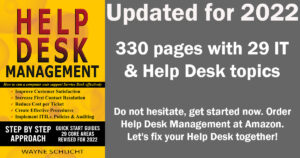
Learn how to implement Help Desk practices and improve customer satisfaction, FCR rates, and lower costs. We identified the top 14 Help Desk Best Practices used by customer support centers. These fourteen selections are critical to the core foundation of a smooth-running Help Desk.
1. Perform an IT Help Desk Maturity Assessment
For an organization initially setting up its Help Desk, there is a lot of industry-standard process information available to build a strong foundation. If you have an established Help Desk, you can have your current processes and practices assessed against these industry standards. This will assist the Help Desk manager to understand how they are doing and what needs attention for improvement. In the IT Service Management community, we start by using something called a maturity assessment. A maturity assessment is a tool used by companies to determine their maturity compared to industry standards. Try the IT Help Desk Maturity Assessment offered by BuildaHelpDesk.com. Implement Help Desk Best Practices.
2. Deploy a Help Desk Mission Statement
Many companies and department leaders will overlook creating and promoting a mission statement. To create an effective department mission statement, you must first understand the purpose. A mission statement defines the reason your company exists, what it does, and how it does it. It may include aspects of operations, highlight products or services, and specifics about unique customers. You may also see mission statements that include company values and what makes the company better than the competition. The company mission statement reflects every facet of the business and all the departments. For these reasons, a mission statement is the cornerstone of your company by communicating its purpose. The mission statement is generally short but powerful.
3. Revise your Help Desk Ticket Categories
Help Desk ticket classification is used to organize support tickets. Other than to keep tickets in a neatly organized system, why should we do
it? Ticket classification is such a big factor in Help Desk’s success. When support tickets are organized properly, it saves money, improves issue resolution metrics, and is an input for other support processes. Learn how to build a Help Desk ticket category classification scheme that increases ticket trend reporting efficiency, enhances the ticket escalation process, improves reporting, and reduces overall support costs.
4. Create a support ticket for every contact
For all support interactions, a Help Desk support ticket must be created. This is a core function of the Help Desk and an important Help Desk Best Practices. A Help Desk support ticket is the official record documenting the support provided. It must be mandatory that this is complied with by the Help Desk agent. Not only must creating a support ticket be mandatory for Help Desk agents, but it must be mandatory for anyone providing support.
5. Employ a quality assurance audit program
How do you really know your Help Desk agents are providing high-quality customer service? As a good Help Desk Manager, in addition to establishing customer contact handling procedures and providing your staff with good customer service training, you must audit agent performance. To truly find out how well your customer contacts are being handled, the Help Desk management team must implement a quality assurance audit. This audit is a program to review calls and tickets on a regular schedule using a standard methodology.
6. Commit to a Total Contact Ownership program
The principle of a Help Desk Total Contact Ownership program is whoever takes the first customer issue will own the issue until it has been resolved. Some refer to this as owning the issue from the cradle to the grave. This means if the issue cannot be resolved on the first contact, the Help Desk agent will follow the ticket through the escalation path. They will provide timely updates to the customer and ensure that the ticket does not linger in a non-resolved status. Both the Help Desk agent and escalation groups work to resolve the issue while the service level agreement clock is ticking. Customer-focused Help Desks using Total Contact Ownership will ensure customer issues are addressed and resolved in a timely manner.
7. Implement a Shift-Left Support Strategy
Implementing a shift-left support strategy has become popular in the IT service management community. A Help Desk shift-left support strategy is based on moving service and support requests from high-cost support engineers and developers to lower-cost tier 1 Help Desk agents. Even better, the shift-left support strategy can also move the work further left by empowering customers to fulfill their needs using self-service tools. By moving work to the left, it will reduce overall cost and free up the time of your IT engineers to work on more productive work. Let us look at how we use our IT engineer’s time more effectively.
8. Build Job Descriptions that work
Well-defined job descriptions are critical to defining the primary functions and duties you expect completed by your staff. Revising the job descriptions used by your Help Desk team is a valuable Help Desk process improvement activity. By updating your job description structure, you will find it easier to build a Help Desk career path and lead to performance management improvements.
9. Embrace employee training and development
Managers know that company success is a result of knowledgeable and engaged workers with the skills to meet their job duties. To develop and keep top talent productive, you need a comprehensive Help Desk training and development program. You often see programs call employee training and development. Both training and development are focused on improving employees’ efficiency, accuracy, and performance in specific areas. However, there is a difference between employee training and employee development. While the difference may be slight, we have tried to identify what each means and identify ways to offer both.
10. Implement automated password management
Do your customers have the ability to reset their passwords using a self-service tool? One of the highest call volume and cost drivers is

password-related calls. Users tend to forget their passwords over weekends, especially on long holiday weekends. To compound the problem, the corporate IT security team will require users to create complex passwords. By implementing a self-service password management system, a Help Desk can reduce incoming call volume. When call volume is reduced, Help Desk Managers can adjust the staffing levels and save money overall. Find out more about the benefits of an Identity and Access Management program.
11. Raise First Contact Resolution (FCR) rates
First contact resolution (FCR) is the percent of customer contacts (incidents) that are solved by the Help Desk in the initial customer interaction without interruption. A successful resolution on the first contact means the issue is resolved before the customer’s initial support session has ended. Improving First contact resolution (FCR) is one of the most important Help Desk Best Practices and directly ties into staffing, cost, and customer satisfaction.
12. Create a Scorecard to track progress
Key performance indicators (KPI) are used by management to understand how the team is performing. It is important to ensure you are capturing accurate data to measure, manage, and implement continuous improvement efforts. Most of your data will come from your phone system, ticketing system, customer surveys, and Help Desk audit program scorecards. Performance reporting is not just one snapshot of a point in time but a trend of all those points in time to determine trends. By comparing the trend data, you can identify the strengths and weaknesses of your Help Desk. It also will allow you to compare your performance reporting against industry standards.
13. Implement Service Level Agreement (SLA)
A service level agreement is a contract between the service provider and the customer. It defines the IT services to be provided by IT to their customers. It also states the time frame the IT service is to be provisioned. It identifies how to measure the effectiveness of the IT service fulfillment and how to report on it. If the service provider fails to meet the provisioning expectations, it details how it should be reported. Once reported, an SLA defines the response format and time frame the service provider is held to respond. It also defines the consequences the service provider could face in failure to deliver to expectations.
14. Organize Knowledge by IT Services
The basic knowledge base structure I recommend is based on IT Services. At the main level of your knowledge base structure, you have the knowledge base home page. The knowledge base home page is your main starting point when searching for knowledge. The knowledge base home page will display the name of each of your IT services and will have a link to the service home page. A service home page is the main page for that service. It describes what the service is and how it is used. It will display many attributes about the service, such as URL, current version, and known issues. The service home page will have links to all the related knowledge solutions. The service solutions are all organized under the service home page. Looking at the graphic for the basic knowledge base structure, you can see how the associations between the pages are arranged.
Leave a Reply